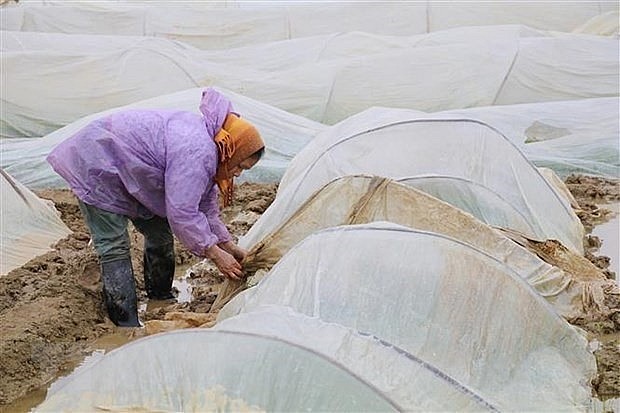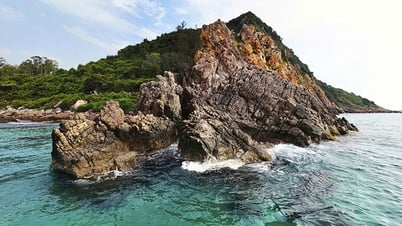Latest cold air news
Currently (February 28), in the North, a cold air mass is moving south. From the night of February 29, Hanoi and the Northeastern provinces, Hoa Binh, Lao Cai, Yen Bai will experience severe cold, and mountainous areas will experience severe cold.
Cold air forecast: Around the evening and night of February 29, this cold air mass will affect the Northeast region, then affect the Northwest and North Central regions. Northeast wind inland will gradually strengthen to level 3, coastal areas level 4-5.

Latest cold air news: Cold on top of cold, the North is about to welcome another strong cold air wave, some places below 5 degrees Celsius. Photo: Cong Thuong Newspaper
The North and North Central regions will be cold, with some places experiencing severe cold; from the night of February 29, the Northeast, Hoa Binh, Lao Cai, Yen Bai regions will experience severe cold, and the mountainous areas will experience severe cold. During this cold air mass, the lowest temperature in the Northeast will be generally 10-13 degrees Celsius, in the Northern mountainous areas from 7-10 degrees Celsius, and in some high mountainous areas below 5 degrees Celsius; in the North Central region, it will be generally 13-16 degrees Celsius.
Due to the strengthening cold air, combined with the current low temperature, the North will maintain a cold condition in late February and early March in the Northeast, Hoa Binh, Lao Cai , Yen Bai regions with the lowest temperature commonly 10-13 degrees Celsius, mountainous areas 7-10 degrees Celsius, high mountainous areas below 5 degrees Celsius.
Regarding the weather at sea: From the evening of February 29, in the Gulf of Tonkin, the northeast wind will gradually increase to level 6, gusting to level 7-8, rough seas, waves 2.0-3.0m high.
From the night of February 29, the northeast wind in the North East Sea gradually increases to level 6, gusting to level 7-8, rough seas; in the Northeast region from March 2, it sometimes increases to level 7, gusting to level 8-9, rough seas; waves from 2.0-4.5m high. From the evening of March 1, the sea from Ninh Thuan to Ca Mau , the west of the South East Sea (including the sea west of Truong Sa archipelago), the northeast wind gradually increases to level 6, gusting to level 7; rough seas; waves from 2.0-4.0m high.

Due to the strengthening cold air, combined with the current low temperature, the North will maintain a cold condition in the last days of February and the beginning of March in the Northeast, Hoa Binh, Lao Cai, Yen Bai regions with the lowest temperature commonly 10-13 degrees Celsius, mountainous areas 7-10 degrees Celsius, high mountainous areas below 5 degrees Celsius. Photo: Vietnam+
Detailed forecast of the upcoming cold spell:
Forecast time | Area of influence | Lowest temperature ( o C) | Average temperature ( o C) |
Night of February 29th, March 1st | Northern Mountains | 8-10, some places under 5 | 9-11 |
Midlands and plains | 11-13 | 13-15 | |
North Central Region | 14-17 | 15-18 |
Warning of possible natural disasters : From the evening and night of February 29 to March 1, the Northern and North Central regions will have scattered rain and light rain. From early morning of March 1 to 3, the area from Quang Binh to Khanh Hoa will have scattered rain and showers and thunderstorms in some places. Thunderstorms may include tornadoes, lightning, hail and strong gusts of wind.
Strong winds and large waves at sea are likely to affect boating and other activities.
Severe cold can affect livestock and poultry; greatly affecting the growth and development of crops.
Cold spells in late February and early March in the past
Mr. Nguyen Duc Hoa, Deputy Head of Climate Forecasting Department, National Center for Hydro-Meteorological Forecasting, said that from 1991 to now, there have been 13 years with severe cold below 15 degrees during the second half of February.
Of these, the two years with the longest cold spell were 6 days (February 22-27, 1995 and February 24-29, 2000). During the 2017-2021 period, there was no cold spell in the second half of February. In 2022, there was a cold spell lasting 4 days (February 20-23).
The cold spell in the North has lasted for 5 days, starting from February 24, due to the influence of moderate cold air combined with the impact of the westerly wind current at an altitude of 5,000 m.
In addition to the cold, the strengthening cold air will also cause light rain in the North on February 29 and March 1. There is a possibility of showers, thunderstorms, and hail in the provinces of Quang Binh - Khanh Hoa on February 1-3.
Northeast wind on land from tomorrow evening will gradually increase to level 3, coastal areas level 4-5. In the Gulf of Tonkin, northeast wind will gradually increase to level 6, gusting to level 7-8, waves 2-3 m high. From the evening of March 1, the sea area of Ninh Thuan - Ca Mau, west of the South East Sea (including the sea area west of Truong Sa archipelago) will gradually increase to level 6, gusting to level 7; rough sea; waves 2-4 m high.
Source



![[Photo] A delegation of 100 journalists from the Vietnam Journalists Association visits the soldiers and people of Truong Sa island district.](https://vphoto.vietnam.vn/thumb/1200x675/vietnam/resource/IMAGE/2025/5/30/0984a986227d4e988177f560d2e1563e)
![[Photo] Journalists moved to tears at the Memorial Service for the soldiers who died in Gac Ma](https://vphoto.vietnam.vn/thumb/1200x675/vietnam/resource/IMAGE/2025/5/30/9454613a55c54c16bf8c0efa51883456)
![[Photo] National Conference "100 years of Vietnamese Revolutionary Press accompanying the glorious cause of the Party and the nation"](https://vphoto.vietnam.vn/thumb/1200x675/vietnam/resource/IMAGE/2025/5/30/1cf6cd5c8a934ebfa347028dcb08358c)

![[Photo] General Secretary To Lam receives Chief of the Central Office of the Lao People's Revolutionary Party](https://vphoto.vietnam.vn/thumb/1200x675/vietnam/resource/IMAGE/2025/5/30/140435f4b39d4599a3d17975dfb444c5)





















































































Comment (0)